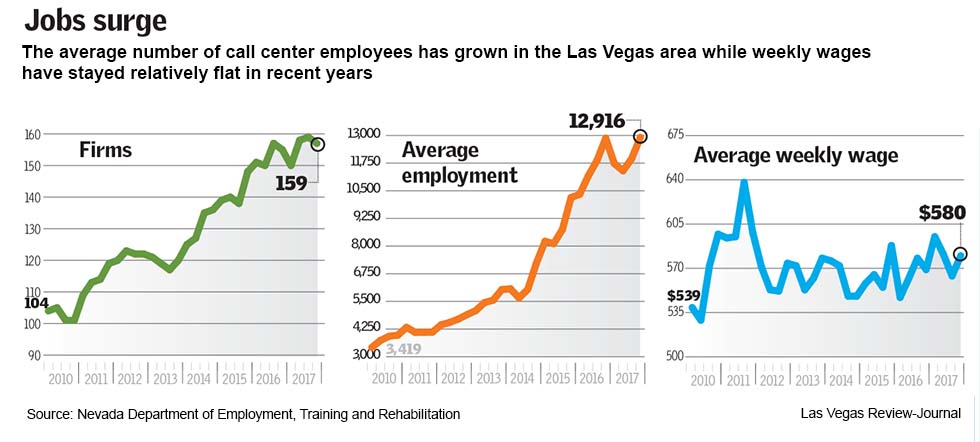Clark County call center employment triples since recession
Michelle Williams thought she’d found a temporary job at a call center that would keep her off her feet during her pregnancy.
Almost 20 years later, Williams directs the Las Vegas site for call center company TTEC, formerly known as TeleTech.
She said she likes the job for the autonomy the company gives her in making decisions that affect her employees.
“My opinions are definitely respected,” Williams said.
When TTEC announced its Las Vegas location in 2017, Williams became one of about 12,000 people employed on average in the local industry. That triples the nearly 4,000 people employed on average in Clark County in 2010, according to state Department of Employment, Training and Rehabilitation data.
In that time, the number of companies went from 101 to 157.
TTEC hired over 300 people during a job fair last month.
Another call center company, Sitel, plans to hire 500 people over the next three months.
Cassidy Klundt, Sitel’s local site director, said a new client partnership has helped with the recent need for employees.
A decision by companies to stop offshoring contact center jobs has helped bring more business to domestic call centers. Consultancy firm International Customer Management Institute estimates the number of U.S. contact center workers at around 3.4 million.
A hub
Low wages, among other assets, have helped Las Vegas become a call center hub.
Last year, call center workers in Clark County made an average weekly wage of $580. In the nearby Phoenix area, call center employees made about $703 a week on average in 2017, according to Arizona state data. 
Plus, hospitality workers come with useful skills for call centers, said Mike PeQueen, managing director of wealth management firm HighTower Las Vegas.
“A relatively large group of moderately educated, service-oriented people available for hire, in a state with low taxes and low real estate costs seems pretty attractive to call center operators,” PeQueen said.
Las Vegas’ transient population also helps to ease the turnover rate at centers, said John Stater, a researcher for real estate firm Colliers International.
Data from the management institute put the average call center turnover rate at 33 percent.
Changes coming
Technology has been slow to disrupt the industry. Fancy Mills, the institute’s group training and content director, said most organizations don’t yet support automation or bots that interact with customers calling or electronically messaging contact centers.
But the institute’s data show that 41 percent of organizations plan to increase use of that technology in the next 12 to 18 months.
The more complicated tasks and customer service calls will still need a human’s attention, Mills said.
Williams, the local director for TTEC, said her company has tried to ease turnover through partnerships with other companies to help employees with day care and transportation to work and handing out awards for jobs well done.
“We have to motivate employees,” she said. “They are our front line.”
Contact Wade Tyler Millward at 702-383-4602 or wmillward@reviewjournal.com. Follow @wademillward on Twitter.

































